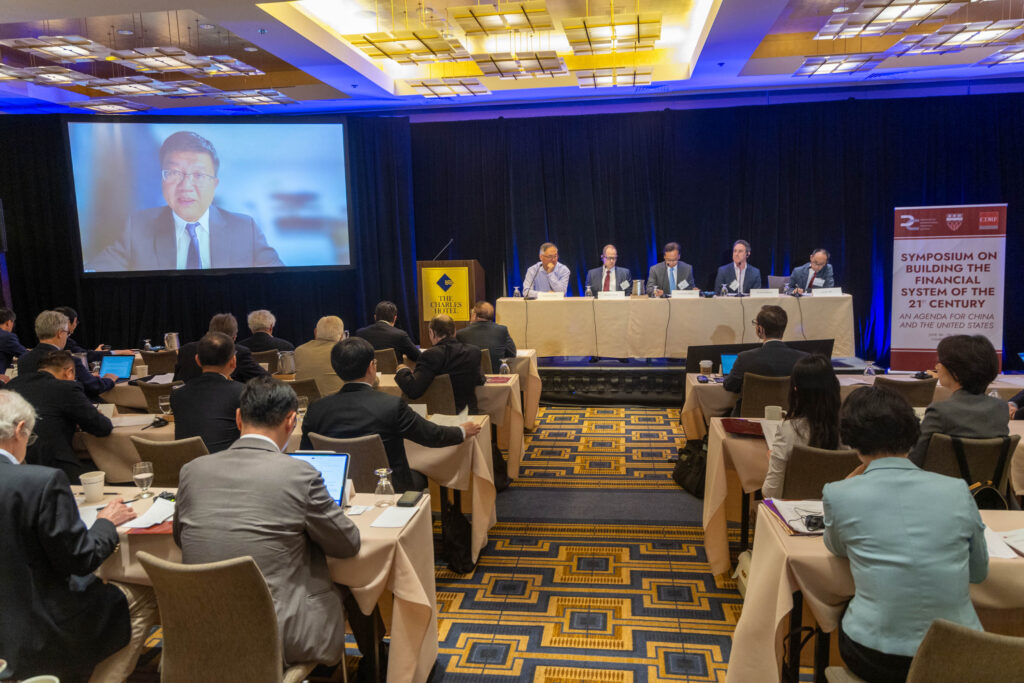Since 2017, Harvard China Fund has been supporting the Program on International Financial Systems (PIFS) in its research and conferences on U.S.-China financial systems. Each year, PIFS convenes one of the most important international symposia on U.S.-China financial relations, bringing together senior policymakers, financial sector executives, and academics to foster dialogue on the two countries’ financial systems.
Ahead of this year’s symposium in Washington, DC, on September 24-26, the Harvard China Fund asked John Gulliver, Executive Director of PIFS, to share insights into challenges facing the U.S.-China financial relationship, the critical policy and industry questions on the conference agenda, and the opportunities for cross-border dialogue and collaboration.
To register for the upcoming symposium in DC, please use the link below.
Register for the 2025 symposium

HCF: How would you describe the state of the U.S.-China financial relationship at this moment?
Gulliver: Dialogue and engagement are ongoing despite obvious political challenges. The financial relationship remains important to both countries. For example, 286 Chinese companies are currently listed on US exchanges and major U.S. financial institutions continue to have a presence in China.
HCF: Why is this important? And why is the conference you are planning for September in DC important?
Gulliver: China and the U.S. are the largest economies in the world, and policy dialogue and engagement are critical for efficient capital allocation and strong economic growth.
Our 23rd annual US-China symposium is a very unique event because it brings together 100-120 leading policymakers, financial institutions, and academics from both the U.S. and China for dialogue on the most important issues impacting the global financial system. The meeting is subject to Chatham House Rule, so discussions are candid. A high-level report of key discussion points is shared with participants and policymakers in the U.S. and China after the symposium.
HCF: Let’s discuss the topics on your agenda. What perspectives will your symposium include regarding tariffs and reserve currencies?
Gulliver: Tariffs and reserve currencies are two of the most important global policy issues right now. We will hear from U.S. and Chinese academics, private sector and government officials on the current state of tariffs, their intended purpose, and their impact on trade and the economy with a forward-looking perspective. The future of global reserve currencies will also be considered, including demand for U.S. dollar assets.
HCF: Is the drive in the U.S. to delink financial systems ostensibly for “security” issues?
Gulliver: Security is a complex matter. With respect to trade policy, the view of the Trump Administration is that the U.S. needs a strong manufacturing base, because otherwise the United States is dependent on access to goods from other countries and could be negatively affected by foreign countries policies. This dependence on foreign nations and their policies is thus viewed by some policymakers as a national security threat.
As for financial delinking, there has been a relationship with security in the past as well. Under the Biden Administration, the U.S. delisted Chinese national security companies from U.S. stock exchanges. In that instance, the national security issue was that U.S. investors were providing low-cost capital to advance the national security interests of China that are not always aligned with U.S. national security interests.
HCF: What is China’s position? Are they pushing to internationalize the yuan, and what would that mean for the global markets?
Gulliver: Yes, China’s sought to expand the use of the Yuan internationally in a variety of ways including their Belt and Road Initiative that provided Yuan financing for infrastructure development in emerging markets. Hong Kong’s recent openness to Yuan-backed stablecoins is another sign that China may be open to future internationalization of the Yuan. Presently Yuan assets constitute less than 5% of global reserve assets, whereas U.S. dollar assets are over 50% of global reserve assets, so this is still very early stages for the Yuan. The relative sizes of the U.S. and Chinese economies are much more comparable, whereas the U.S. dollar remains as the global reserve asset of choice.
HCF: Your agenda also includes digital assets. What can participants in your symposium expect to learn about digital assets?
Gulliver: Digital assets policy is rapidly evolving in the United States. President Trump recently signed into law new federal legislation on “stablecoins” that are pegged to the U.S. dollar, and the U.S. Congress is set to consider broader market structure regulation of other digital assets, like Bitcoin, as soon as this Fall. China is conducting trials of a digital yuan, and Hong Kong has recently opened up to stablecoins as well. The symposium will consider the future implications of digital assets policy for the global financial system.
HCF: Finally, your symposium will cover the future of financial services in the U.S. and China more broadly. Any specific issues come to mind.
Gulliver: One key issue that will be discussed is the future of U.S.-listed Chinese companies. In 2020, President Trump signed the Holding Foreign Companies Accountable Act into law. The act requires that U.S.-listed Chinese companies provide U.S. regulators with the ability to inspect their audit records. This resulted in Chinese regulators providing U.S. regulators with expanded access to audit records during the Biden Administration. The future of the existing agreement under new leadership at the U.S. Securities and Exchange Commission and U.S. audit regulator will be discussed.